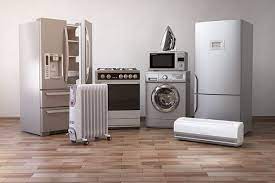Where to Go? Home Appliance’s Next Step
It has been more than 100 years since home appliances came to the world. When it talks about the birthplace of home appliances, the United States is always the first to be mentioned. In fact, when Thomas Edison invented the incandescent lamp in 1879, the era of household electricity started. The evolution of electric power in the United States has created advantageous conditions for the development of household appliances. At the beginning of the 20th century, Earl H. Richardson, a meter reader in California, improved the iron after his wife’s suggestion. Richardson was not the first to invent the iron, but his new version was popular among women. The widespread use of electric irons changed the tradition of only providing electricity at night and led to the advent of other household appliances. As a result, it is believed that the home appliance industry in the United States began with electric irons. More and more modern appliances were put on the market as time passed. For example, the vacuum cleaner with the prototype of the modern product came out in 1907. And in the early twenty century, electric washing machines and compressor-type refrigerators began to show in the house. In 1914 the electric stove appeared. In 1930, air conditioners used in rooms were introduced. On the other hand, Vladimir Kosma Zworykin assembled the world’s first fully electronic television system in 1931. Then, in 1937, the fully automatic washing machine was successfully developed. From that time on, electrical appliances products have grown rapidly, and the types are continuously increased and diverse. The rise of the electronics industry and the plastics industry in the 1950s also promoted the rapid development of household appliances. The invention and application of integrated circuits (IC) have brought electronic technology into the era of microelectronics technology and have raised household appliances to a new level. In the 1970s, the advent of micro-computers guild household appliances in the direction of automation and intelligence. In contemporary times that refer to the late twenty century, home appliances have also caught up with this train with the widening use of IoT technology, such as IoT refrigerators, washing machines, air conditioners, microwave ovens, water heaters, etc. have appeared one after another. Several high-tech household appliances show an intelligent and efficient life in the future.
Now, in the twenty-first century, more concepts like low-carbon energy-saving and smart homes are blended with appliances. Various favourable factors have prompted the emergence of new types of home appliances which have become a new game space for the home appliance industry. With the coming 5G era, the application of smart home appliances has become increased and border, and AI technology has begun to be integrated into the smart home appliances system. Smart home appliances have more functions and can be used smartly. One new trend is smart kitchens. Smart refrigerators have been one of the key products in smart home appliances in recent years. The smart refrigerator can recommend suitable recipes according to the types of ingredients with their expiration date or other data. Some smart refrigerators even can order ingredients online automatically when the ingredients run out. Smart ovens, electric cookers or electronic pots will automatically adjust the cooking time and temperature according to the ingredients. All this makes home life more intuitive and more convenient.
As the sales of memory and smartphones have slowed down, SAMSUNG Electronics is looking for new revenue sources. In 2017, SAMSUNG started developing AI home appliances in its USA R&D center. One of the under-developing products is the robot chef “Bot Chef”. This robot arm has built-in sensors. The selling point is that while entering the recipe, the robot chef can cut vegetables, prepare seasonings, and cook like a human all at once. The way to activate the robotic chef is a simple voice command: “Hey, robotic chef, let’s make a salad.” The two white robotic arms hang upright from the kitchen cabinets. The robot chef has six degrees of freedom, four main arm joints, and three fingers that can pinch and hold various kitchen tools. The diameter and length of the hand are modelled by the human arm. When Bot Chef was shown on the SAMSUNG CES stand, it was really astonishing. But, at present, the machine chef is still not perfect and needs to optimise. It is still difficult for robots to act smoothly like humans and add seasonings or cut the konjac into pieces when cooking. SAMSUNG said it is hard to predict when the product will be available to be launched. One South Korean home appliance analyst estimates that commercialisation is three years away. SAMSUNG USA R&D center has also developed a smart refrigerator, “Chef Garden”, which has a built-in mini hydroponic vegetable field. The garden uses AI programs to adjust water temperature, lighting, temperature, and humidity to create a suitable growth environment. This cultivation method requires no pesticides and is quite popular in the South Korean metropolitan area. SAMSUNG expects it will receive a good response in other countries as well.
Looking back on the development history of home appliances, we can find that home appliances have changed from conspicuous goods to common and simple consumer products. While consumer demand is increasing day by day, traditional home appliances can no longer meet the market demand. The drive from the consumers and the improvement of technology have brought the continuous evolution of smart home appliances. When the basic functions are fully satisfied, consumers put the emphasis on home appliances’ quality and personalization. This is an inevitable process in the development of the home appliance industry. When robots start to replace humans in the kitchen, what will happen in the next decade?

